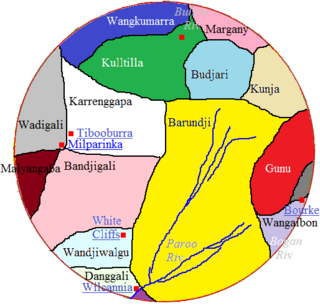The Kuungkari are an indigenous Australian people of Queensland. They are to be distinguished from the Kunggari.

The Wadjiga people, also known as Wadja, Maudalgo, Wadjainggo, and other variants, were an Aboriginal Australian people of inland eastern Queensland.
The Wakabunga are an indigenous Australian people of the state of Queensland.
The Wadjalang, also known as the Dharawala, were an indigenous Australian people of Queensland.

The Karenggapa are an Aboriginal Australian people of New South Wales.
The Wanggumara, also spelt Wangkumara, Wongkumara, Wangkumarra, and other variants, are an Aboriginal people of the state of Queensland, Australia.
The Bidjara people, also spelt Bitjara or Bithara, are an Aboriginal Australian people of south-western Queensland. They spoke a dialect of the Ngura language. They are not to be confused with the Warrego River Pitjara or the Badjiri of the Paroo River, both of whose traditional lands are further to the east of the state.
The Bidjara or Pitjara are an Aboriginal Australian people of eastern Queensland. They are to be distinguished from the Bidjara of southwestern Queensland and the Badjiri of southern Queensland.
The Dhiraila were an Aboriginal Australian people of the state of Queensland.
The Maranganji are an Aboriginal Australian tribe from southwest Queensland.
The Galali or Kalali were an indigenous Australian people of the state of Queensland.
The Maikulan were an indigenous Australian people of the state of Queensland. They have sometimes been confused with the Maithakari.
The Maikathari (Mayi-Thakurti) were an Aboriginal Australian people of the state of Queensland.
The Ganulu, also spelt Kanolu, are an Aboriginal Australian people of the state of Queensland.
The Ringaringa (Ringu-Ringu) were an indigenous Australian people of the state of Queensland.
The Yilba, also written Ilba and Jilba, are or were an Aboriginal Australian people of the present-day state of Queensland.
The Yagalingu are an Aboriginal Australian people of the state of Queensland. Their language may have been a dialect of Bidjara.

The Bindal are the Aboriginal Australian people whose ancestors originally possessed, occupied, used and enjoyed approximately 2600 km2 of coastal country from the mouth of the Burdekin River north to Cape Cleveland, inland to Leichhardt Range, in the state of Queensland
The Djankun are an Aboriginal Australian people of Far North Queensland.
The Gawambaraay (Kawambarai) are an Aboriginal Australian people of the state of New South Wales, closely connected to the Gamilaraay (Kamilaroi) people. Their traditional lands are in the central–western district of New South Wales
This page is based on this
Wikipedia article Text is available under the
CC BY-SA 4.0 license; additional terms may apply.
Images, videos and audio are available under their respective licenses.



